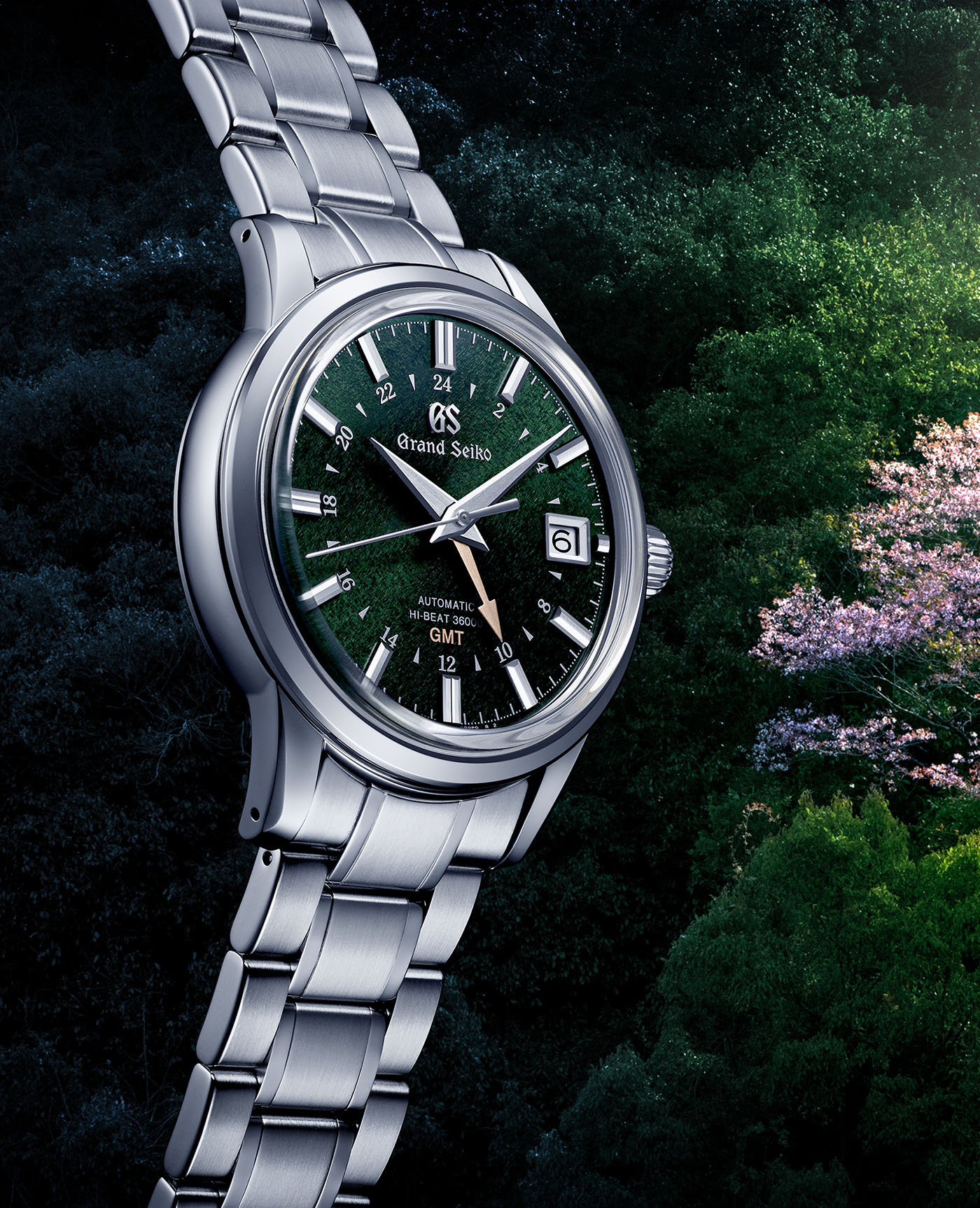
The natural beauty of Japan has been at the heart of Grand Seiko’s design inspiration for the past several years, with models inspired by everything from snowdrifts to tree bark to the delicate tones and textures of cherry blossoms. One of the standout examples of this philosophy is the 2019 Seasons collection, a series of four North American exclusive designs aimed at highlighting the unique seasonal feel of Japan at different times of the year. Grand Seiko has returned to this concept for 2021 with the GMT Seasons collection, which breaks down the year further into the traditional Japanese concept of sekki. Sekki, or seasonal phases, are the 24 distinct phases of the Japanese natural year, with six each for spring, summer, fall, and winter. The new Grand Seiko GMT Seasons series includes the Grand Seiko SBGJ251 Shunbun, Grand Seiko SBGJ249 Shōsho, Grand Seiko SBGE271 Kanro, and Grand Seiko SBGE269 Tōji, showcasing the brand’s naturalistic design ethos with both Spring Drive and Hi-Beat automatic movements.

All four models in the Grand Seiko GMT Seasons collection use a stainless steel version of the brand’s Elegance GMT case design. This is a more traditional, classically styled alternative to the angular “Grammar of Design” forms that inform much of the brand’s lineup, with simple chamfered tapering lugs and a narrow smooth bezel. Naturally, this more classical design still features the brand’s signature touches, like Zaratsu polishing and razor-sharp chamfering. All four models also feature a box sapphire crystal and a sapphire display caseback to showcase the movements within, but models with different movements have slightly different case dimensions. The automatic powered Grand Seiko SBGJ251 Shunbun and SGBJ249 Shōsho measure in at 39.5mm-wide and 14.1mm-thick, while the Spring Drive-equipped SBGE271 Kanro and SBGE269 Tōji are a hair wider and thinner at 40.2mm-wide and 14.0mm-thick.

As with most modern releases from the brand, the real standout elements of the Grand Seiko GMT Seasons collection are the dials. Each represents a single phase of the 24 part sekki cycle, using natural cues to express a different facet of Japanese nature. First up is the Grand Seiko SBGJ251 Shunbun. Shunbun is the very beginning of spring, right at the spring equinox, and Grand Seiko looks to capture the verdant new growth and the first emergence of cherry blossoms with a deep green dial featuring a grassy random crosshatch pattern. A soft pink rose gold alloy is used for the GMT hand and dial text, nicely adding the cherry blossom color in initial images. Next is the Grand Seiko SBGJ249 Shōsho, representing the end of the rainy season in early summer. In Shōsho, warm winds cause water in lakes and ponds to ripple distinctively, which Grand Seiko interprets with a pale silvery blue dial with a blued GMT hand and 24-hour scale. This deeply carved and textured dial surface looks to capture the feeling of light on rippling water but might require in-person viewing to get the full effect.

For the dial of Grand Seiko SBGE271 Kanro, the brand turns its attention to the night sky. Kanro is the height of autumn, when the winds turn cold and the nights grow longer, and to express this moment the marque goes with a chaotic patter of brushed layers, all with grain in different directions. It’s a similar finish to the “Lion’s Mane” limited edition sports models Grand Seiko produced in 2019, but where those models used a blend of brown tones to simulate a lion’s fur the Kanro interprets the finish in black and shades of gray. The effect is meant to echo moonlit clouds moving across the sky, while gold accents bring in a touch of color. Lastly, there is the Grand Seiko SBGE269 Tōji. Tōji is the time of the winter solstice, where the air is clear and the sun rises low over the snow. Like several classic Grand Seiko models before it, the silvery dial of the SBGE269 Tōji looks to capture the feel of a Japanese snowfall, but here the effect is more placid and grainy, almost stucco-like in initial images rather than the blizzards and snowdrifts of previous interpretations. The rose gold GMT hand and dial text add a burst of refined warmth, meant to symbolize the look of the setting sun over a snowy landscape.

In terms of dial layout, all four models follow standard Grand Seiko GMT conventions, with the SBGJ251 Shunbun and SBGJ249 Shōsho using wide, sharply beveled applied indices, short arrow GMT hands, and a prominent inner 24 hour scale. For the Spring Drive powered SBGE271 Kanro and SBGE269 Tōji, the skeleton tipped GMT hands are longer and narrower, with an outer railroad seconds track, minimal 24 hour scale, and a 7 o’clock power reserve indicator.

All four models in the Grand Seiko GMT Seasons collection are powered by in-house movements. For the SBGJ251 Shunbun and SBGJ249 Shōsho, this is the 9S86 automatic GMT movement. The 9S86 offers impressive accuracy, within +5/-3 seconds per day, and a solid 55-hour power reserve with a smooth 36,000 bph beat rate. The SBGE271 Kanro and SBGE269 Tōji are equipped with the 9R66 Spring Drive GMT movement, using Seiko’s proprietary technology to offer the trademark completely smooth gliding seconds hand. Accuracy is within 15 seconds per month, with a power reserve of 55 hours.

Each model in the Grand Seiko GMT Seasons collection is finished with the brand’s take on the classic three-link oyster-style bracelet, with a pair of polished highlights flanking the center links and a push-button butterfly clasp.

With a continued commitment to natural inspirations and a range of looks to suit a variety of tastes, the Grand Seiko GMT Seasons collection is a robust and expressive addition to the brand’s GMT stable. The Grand Seiko SBGJ251 Shunbun and the Grand Seiko SBGJ249 Shōsho will be available at authorized dealers and Grand Seiko boutiques in May 2021 at an MSRP of $6,800 each, while the Grand Seiko SBGE271 Kanro and SBGE269 Tōji will be available from September 2021 at an MSRP of $6,000 each. For more details, please visit the brand’s website.

